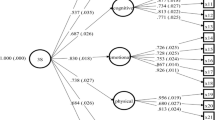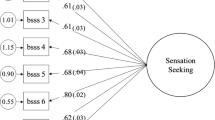Abstract
A new form (VI) of the Sensation Seeking Scale (SSS) was developed which separates reports of past experiences from desired or intended future experiences on both Disinhibition (Dis) and Thrill and Adventure Seeking (TAS) factors. Factor analyses were used to select items for the scales. High internal reliabilities were found for the Experience-Dis, Intention-TAS, and Intention-Dis scales, but only moderate reliability was found for the Experience-TAS scale. Retest reliabilities were high for all scales. The Experience-TAS and -Dis scales were highly correlated for males but not for females. The Experience- and Intention-TAS scales were moderately correlated, and the Experience- and Intention-Dis scales were highly correlated for both sexes. Both the TAS and the Dis scales on form V were highly correlated with the corresponding Intention scales on form VI. Uses for the new SS scales in individual assessment are suggested.
Similar content being viewed by others
References
Blackburn, R. (1969). Sensation seeking, impulsivity and psychopathic personality.Journal of Consulting and Clinical Psychology, 33 571–574.
Daitzman, R. J., Zuckerman, M., Sammelwitz, T., & Ganjam, V. (1978). Sensation seeking and gonadal hormones.Journal of Biosocial Science, 10 401–408.
Emmons, T. D., & Webb, W. W. (1974). Subjective correlates of emotional responsivity and stimulation seeking in psychopaths, normals and acting-out neurotics.Journal of Consulting and Clinical Psychology, 42 620–625.
MacPhillamy, D. J., & Lewinsohn, P. M. (1982). The pleasant events schedule: Studies on reliability, validity, and scale intercorrelation.Journal of Consulting and Clinical Psychology, 50 363–380.
Mellstrom, M., Jr., Cicala, G. A., & Zuckerman, M. (1976). General versus specific trait anxiety measures in the prediction of fear of snakes, heights, and darkness.Journal of Consulting and Clinical Psychology, 44 83–91.
Zuckerman, M. (1974). The sensation seeking motive. In B. A. Maher (Ed.),Progress in experimental personality research, Vol. 7 (pp. 79–148), New York: Academic Press.
Zuckerman, M. (1978). Sensation seeking. In H. London & J. Exner (Eds.),Dimensions of personality (pp. 487–559). New York: Wiley.
Zuckerman, M. (1979).Sensation seeking: Beyond the optimal level of arousal. Hillsdale, NJ: Erlbaum.
Zuckerman, M. (1983a). A biological theory of sensation seeking. In M. Zuckerman (Ed.),Biological bases of sensation seeking, impulsivity and anxiety (pp. 37–76). Hillsdale, NJ: Erlbaum.
Zuckerman, M. (1983b). Sensation seeking and sports.Personality and Individual Differences, 4 285–292.
Zuckerman, M., Ballenger, J. C., Jimerson, D. C., Murphy, D. L., & Post, R. M. (1983). A correlational test in humans of the biological models of sensation seeking, impulsivity, and anxiety. In M. Zuckerman (Ed.),Biological bases of sensation seeking, impulsivity and anxiety. (pp. 229–248). Hillsdale, NJ: Erlbaum.
Zuckerman, M., Buchsbaum, M. S., & Murphy, D. L. (1980). Sensation seeking and its biological correlates.Psychological Bulletin, 88 187–214.
Zuckerman, M., Eysenck, S., & Eysenck, H. J. (1978). Sensation seeking in England and America: Cross-cultural, age and sex comparisons.Journal of Consulting and Clinical Psychology, 46 139–149.
Zuckerman, M., Murtaugh, T., & Siegel, J. (1974). Sensation seeking and cortical augmenting-reducing.Psychophysiology, 11 535–542.
Zuckerman, M., & Neeb, M. (1980). Demographic influences in sensation seeking and expressions of sensation seeking in religion, smoking, and driving habits.Personality and Individual Differences, 1 197–206.
Author information
Authors and Affiliations
Additional information
A copy of SSS form VI may be obtained from the author.
Rights and permissions
About this article
Cite this article
Zuckerman, M. Experience and desire: A new format for Sensation Seeking Scales. Journal of Behavioral Assessment 6, 101–114 (1984). https://doi.org/10.1007/BF01350166
Accepted:
Issue Date:
DOI: https://doi.org/10.1007/BF01350166




